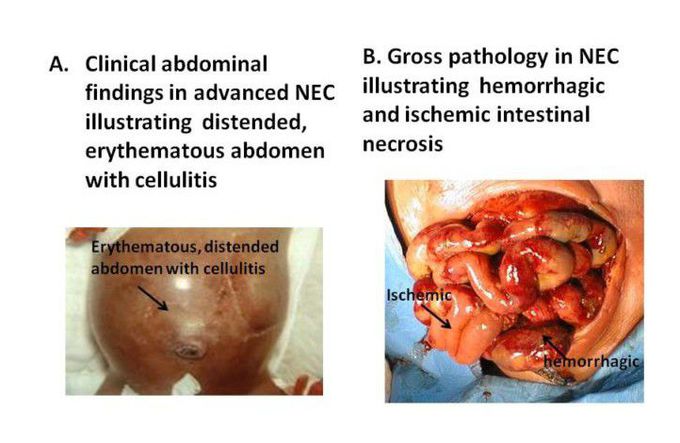


OVERVIEW: What every practitioner needs to know Are you sure your patient has necrotizing enterocolitis (NEC)? What are the typical findings for this disease?
Necrotizing enterocolitis (NEC) is an acute inflammatory disease of the gastrointestinal tract of preterm infants that was initially described in the 1950s. The pathology of NEC can range from limited mucosal injury to full thickness necrosis of the small and large intestine. The distribution of injury may be focal, segmental, multifocal, or diffuse. The three most common signs of NEC are as follows: • Abdominal distention • Bloody stools (grossly bloody, or heme-positive for occult blood); and • Excessive gastric residuals (fed infants) or bilious gastric aspirates (unfed infants). OVERVIEW: What every practitioner needs to know Are you sure your patient has necrotizing enterocolitis (NEC)? What are the typical findings Necrotizing enterocolitis (NEC) is an acute inflammatory disease of the gastrointestinal tract of preterm infants that was initially described in the 1950s. The pathology of NEC can range from limited mucosal injury to full thickness necrosis of the small and large intestine. The distribution of injury may be focal, segmental, multifocal, or diffuse. The three most common signs of NEC are as follows: • Abdominal distention (See Figure 1) • Bloody stools (grossly bloody, or heme-positive for occult blood); and • Excessive gastric residuals (fed infants) or bilious gastric aspirates (unfed infants). Other signs referable to gastrointestinal pathology include vomiting, diminished to absent bowel sounds with ileus, abdominal tenderness, cellulitis of the abdominal wall, and less commonly, a palpable abdominal mass. The effects of the acute inflammatory process in NEC typically extend beyond the gastrointestinal tract. Systemic signs such as lethargy, new onset or increased episodes of apnea, new onset of respiratory distress or worsening of respiratory distress, poor color, diminished peripheral perfusion, bleeding diasthesis, hypotension, bradycardia, and shock syndrome are almost always observed at some stage in the disease process. These systemic signs may occur even if cultures of blood and other body fluids are sterile. Pathology similar to NEC in preterm infants has occurred in term infants with other conditions such as cyanotic congenital heart disease, Hirschsprung’s disease, imperforate anus, intestinal atresia, and severe perinatal asphyxia. However, the etiology and pathogenesis of intestinal injury in these situations likely differs from that of classic NEC in preterm infants. Isolated intestinal perforation (IIP) is a distinct entity that results from a punctate perforation of the gastrointestinal tract. IIP can present with marked abdominal distention due to a pneumoperitoneum and systemic signs of sepsis due to intraperitoneal spillage of fecal organisms. This entity has been associated with medications such as indomethacin and steroids.

